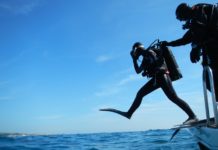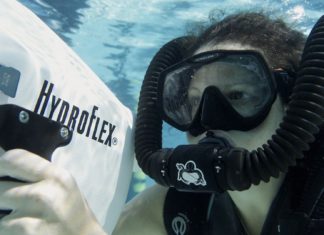Scuba diving is a fun sport that can be enjoyed by most people of all ages and levels of fitness. But with any activity, there are rules and risks. One of the most important rules in diving is to always ascend slowly, no matter from which depth. In fact, it’s more important to ascend slowly from a shallower depth as the pressure change is greater.
Learning how to ascend in scuba diving safely is something that every diver will learn, regardless of skill level. You will need to watch out for passing boats above so that you don’t get run over, and you will need to go up slowly to reduce your risk of decompression sickness. So why is it important to ascend slowly in scuba diving and what are the steps to be a safe diver?
Read More: Common Scuba Diving Dangers and How to Avoid Them!
WHY IS A SLOW ASCENT IMPORTANT
Ascending slowly in scuba diving is so important. This is because you want to reduce the risk of Decompression Sickness (DCS), which can cause tingling in your arms and legs, pain in your joints, and even death.
What is the Most Prominent Symptom of Decompression Sickness?
When we go diving, we breathe in (inhale) air from our tank. This air is a mixture of roughly 21% Oxygen and nearly 79% Nitrogen. This is very similar to what we are currently breathing on land. Our bodies will use that oxygen to live, but we breathe out (exhale) that nitrogen that we don’t need.
However, when we go under pressure or go diving underwater, the pressure is greater. This means we are breathing in more oxygen, and ultimately more nitrogen, but we cannot exhale that nitrogen fast enough. It then gets absorbed into our blood cells, which is fine when it can be released slowly. But if we ascend too fast, then that absorbed nitrogen will pressurize and can bubble out of the blood stream. If these nitrogen bubbles get caught and stuck in our blood stream then this is when we can get DCS.
SIMPLIFIED: Imagine your body is a can of fizzy drink. If you shake it and open it, then the pressure will explode and your drink will be all over you. But if you shake it and open it slowly, release that pressure bit by bit, then you will be safe from a messy drink, and also safe from DCS!
So how to ascend in scuba diving slowly and safely?
HOW TO ASCEND IN SCUBA DIVING
The best way to ascend is the safest way. For this we need to do the following steps:
LOOK UP
Look up and watch for boats above. If you see a shadow of a boat above you, then move to another spot to make your ascent.
LISTEN FOR BOATS
Listen for boats and motors that may be above you. If you hear a loud motor, then wait for it to pass before making your ascent. If it is still running, then move to another spot where the sound is not as loud.
INFLATE A SURFACE MARKER
Inflate your Delayed Surface Marker Buoy (DSMB) and release it to mark your ascent spot. This warns boats and people that you will be ascending and to keep clear of the area. But remember, in waves or low visibility, sometimes the boat will not see you. This means it is mainly your own responsibility to look and listen for boats.
Alternatively, you may have a Dive Flag already above you. Remember to stay close to this.
MAKE A SAFETY STOP
Make your safety stop if you have not already done so. This is usually staying at a depth of 5 meters / 15 feet for 3 minutes to give your body some extra time to unload the absorbed nitrogen from the dive.
SLOWLY KICK AND SWIM UP
When you are ready to ascend, hold your inflator hose in your left hand and have your finger on the deflate button. You should start to kick up slowly, while continuously releasing air from your BCD. This stops the air in your BCD from expanding too much and pulling you up too quickly!
DEFLATE AIR FROM BCD TO STOP IT EXPANDING
If you notice you are going up too fast, then slow down your kicking and make sure to release the air from your BCD.
WATCH YOUR ASCENT RATE
Watch your dive computer and follow the ascent rate on the computer. If you go up too fast, most computers will start to beep to warn you to slow down.
If you are using a DSMB, make sure you are not getting tangled in the line. Reel it up slowly or keep the line out in-front of you.
PROTECT YOUR HEAD WITH YOUR RIGHT ARM
As you get closer to the surface, look up and scan the surface for any people, boats or obstructions. You don’t want to pop up in-between someone’s legs!
Raise your right arm above you to protect your head in case of any last minute obstructions. Better to lose an arm than your head to a passing speedboat!
BE READY TO INFLATE WHEN ON THE SURFACE
Make sure you left arm is on the inflator hose and ready to press the inflate button when you break the surface. Inflate your BCD fully when you are on the surface. Remove your regulator and mask if safe to do so and swim back to your boat or shore!
In simple terms:
- LOOK UP
2. LISTEN UP
3. PUT UP A MARKER
4. KICK UP SLOWLY
5. RELEASE AIR FROM YOUR BCD
6. WATCH THE ASCENT RATE ON YOUR DIVE COMPUTER
7. PROTECT YOUR HEAD WITH YOUR RIGHT ARM
8. BE READY TO INFLATE WHEN ON THE SURFACE
Read More: How Do Scuba Divers Go Up and Down?
COMING UP TOO FAST SCUBA DIVING
So let’s say that you couldn’t release enough air from your BCD and it pulled you up quicker than you expected. Or you kicked a bit too hard and swam up too quickly. Your computer is beeping like crazy, and you pop up to the surface wondering if your limbs are going numb and clutching your joints thinking you have pain.
There are 2 ways this could go.
Option 1 is that you go back to the boat, fearing for your life, but you feel no pain. This is when you should lay down, take it easy, have emergency oxygen on stand-by and play the waiting game. You and your buddy will monitor yourself for any symptoms of DCS. Symptoms can still arise after 12 hours, so make sure you are not alone and have someone to call.
Read More: Why is Decompression Sickness Called ‘The Bends?’
Option 2 is that you feel symptoms of DCS, whether it’s straight away or later. Make sure you lay down, breathe 100% oxygen and have someone call Emergency Medical Services (EMS). If severe symptoms persist, then they will put you in a recompression chamber or hyperbaric chamber. In the chamber you will be exposed to increasing pressure, simulating a dive and compressing the nitrogen bubbles in your blood. The chamber will then slowly release that pressure, over a long period of time, as if you were ascending slowly. This allows that nitrogen to properly release and your symptoms should subside. The duration you are in the chamber will depend on your symptoms, generally it will be several hours over a few days.
WHAT ARE THE SYMPTOMS OF DECOMPRESSION SICKNESS (DCS)?
Here are some of the symptoms of DCS at a glance.
MILD
- joint pain
- Extreme fatigue / feeling tired
- Itching
- Tingling or pins and needles in your arms and legs
SEVERE
- Extreme tingling
- Dizziness
- Confusion
- Memory loss
- Chest pain
- Trouble walking
- Trouble speaking
- Losing consciousness
CONCLUSION
Scuba diving is a safe activity (safe enough for children) but like with anything there are some safety rules. One of the most important rules is to always ascend slowly as this allows your body’s absorbed nitrogen to release and not build up in your blood stream. If you do go up too fast, you will have a real risk of DCS which can be painful, paralysing and in worse cases, fatal. However, this is just a risk and not a guarantee that you will get sick. So the best way to avoid the risk is to learn how to ascend in scuba diving safely and slowly by following our tips!





























